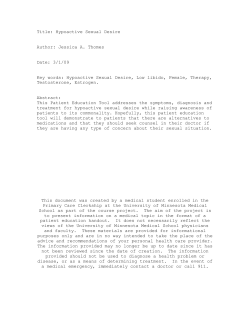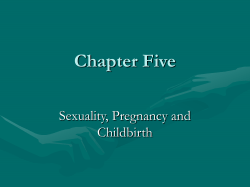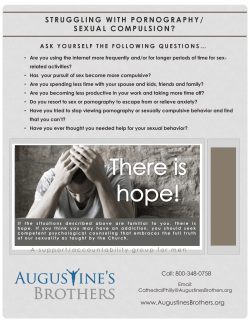
Arousal and Response Lighting the fire, Stoking the flame
Arousal and Response Lighting the fire, Stoking the flame The Essential Hormones • Two basic types – Steroid & Neuropeptide • Steroid Hormones – secreted by the gonads and adrenal glands • Examples: testosterone, estrogen, etc. • Not simply male or female – both sexes produce each, but in varying amounts Neuropeptide Hormones • Produced in the brain, they influence sexuality and behavior • Perhaps the most significant: • Oxytocin – the “love hormone”, it influences our erotic and emotional bonds Testosterone – “the motivator” • Men have 20 to 40 times • • • more Effects desire (libido) more than function But deficiencies do decrease sensitivity and desire Castration – the surgical removal of the testes causes dramatic reductions in sexual interest and desire Testosterone uses Less Testosterone • Antiandrogens – drugs which reduce testosterone levels • Occasionally given to sex offenders • Usually decreases sexual interest and activity • But sometimes offenders assault for other reasons , such as anger, power and control • Hypogonadism – testosterone deficiency due to diseases of the endocrine system • If it begins before puberty, development is slowed • If it starts after puberty, a marked decrease in desire follows Estrogens and Desire • Their influence is undeniable but exact role is unclear • Research findings differ as to whether they increase desire Females & Testosterone • Testosterone clearly increases female sexual desire, sensitivity and activity • True even for women after menopause or removal of the ovaries • Women with “normal” levels of sexual activity and hormones who receive additional testosterone show significant increases in sexual arousal, sensation and even lust • Theresa Crenshaw “…. when a woman’s testosterone dwindles, so does her sex life.” More On Testosterone • Women have much less testosterone, but are much more sensitive to its effects • For women, too much testosterone causes problems, such as “unwelcome” changes to secondary sexual characteristics • Women see levels fall more rapidly after menopause than male’s more gradual decline • If measured, it is “free” (unattached) testosterone that matters, not “total” • Testosterone Replacement Therapy commonly available for men now, slowly becoming an option for women Marketing Testosterone oxytocin • A neuropeptide from the hypothalamus that effects sexual response and attraction • Bonding occurs through its release mother/child – breast feeding sexual partners – arousal and response • Autistic children have low levels and corresponding difficulties forming bonds and expressing love Oxytocin and Love • Release is triggered by touch • Its circulation increases the skins sensitivity to touch • Levels increase within us as we go through the cycle of arousal to orgasm • Presence remains in blood stream after orgasm facilitating pair bonding The Brain – Our Most Sexual Organ? • Our cerebral cortex stores memories and images producing powerful fantasies • Our culture has conditioned us to have certain preferences for what we consider physically attractive • World-wide prototypes? Exemplars of Beauty • A 2005 poll of plastic surgeons revealed the following as possessing the most desired: • Nose – Nicole Kidman • Eyes – Catherine Zeta Jones • Lips – Angelina Jolie Nose Eyes Lips The Limbic System • A subcortical brain system of several related structures that impact sexual behavior • Investigated through a number of studies Olds (1950’s) • Implanted electrodes in rat’s limbic system • Allowed them to control stimulation • When given the chance, rats will “dial their own number” until they reach exhaustion, even up to several thousand times an hour • “pleasure centers” Heath (1972) • Humans with a variety of disorders were allowed to self-stimulate their limbic system • One man pushed his button over 1500/hr, described intense sexual pleasure, and complained whenever a “session” ended • A woman reported similar experiences, even multiple orgasmic responses The Hypothalamus • Stimulation greatly arouses rats • Its destruction crushes response • Apparently, the medial preoptic area (MPOA) is especially sensitive • Heroin, morphine and other opiates suppress activity of the MPOA • Dopamine and testosterone excite it Serotonin’s Influence • Presence inhibits sexual activity • Seems to have the opposite effects of dopamine • Released after males ejaculate and blocks or dampens sensitivity to dopamine and oxytocin • SSRI’s have many negative effects on sexuality The Senses • Many sources of erotic stimulation • Their influence leads to tremendous variety and amazing sexual complexity Touch • Our nerve endings are unevenly distributed, locations which are most sexually responsive are called our • Primary Erogenous Zones, which include our genitals, lips, buttocks, inner thighs, neck, mouth, perineum • But we find tremendous variability • Secondary Erogenous Zones other areas touched within the context of sexual intimacy • Could be anywhere on the body • Established through classical conditioning? Vision • Very important in our society • Emphasis on physical attractiveness, grooming, clothes and cosmetics • Are males more aroused by visual stimuli? • Kinsey’s survey said, “YES!” • But once women were presented with the: 1) right stimuli, 2) in the right settings, and 3) measured the right way, STRONG similarities between men and women were found though women’s self-reports say no Smell • Are genitals smells arousing or awful? • Depends largely on where you live and your acceptance or rejection of fragrance claims. Pheromones • Odors secreted by the body which relate to reproduction • Common for mammals • The vomeronasal system relates to their use • Present in humans, • But is it functional? What Works • Smells that arouse • Women – licorice, • banana nut bread, cucumbers Men – lavender, pumpkin pie, doughnuts What Doesn’t • Women – barbecued meat, men’s cologne’s • Men – Nothing Aphrodisiacs • Substances that supposedly increase sexual desire and capacity Do They Deliver? • Many claims – little evidence • Alcohol, amphetamines, barbiturates, cocaine and marijuana reduce inhibitions but also sexual response • The power of suggestion seems key Hope on the Horizon? • One substance, yohimbine hydrochloride (sap of the tropical evergreen) does increase desire and performance Anaphrodisiacs • Substances which inhibit sexual desire and performance • Many things “work” • Drugs such as opiates, tranquilizers, and antidepressants inhibit ejaculation and cause erectile problems in males and decrease orgasmic capacity for females Other Anaphrodisiacs • Birth control pills decrease free testosterone levels • Nicotine both decreases vasocongestion and reduces testosterone levels Sexual Response • A highly individualized process • Research has revealed common patterns of physiological changes Kaplan’s Three Stages • Desire – a prelude to physical sexual response, ignored by Masters and Johnson • Excitement • Organism • Masters and Johnson • Sexology Trailblazers • Direct Observation Masters and Johnson’s Four Phases • Excitement both men and women: muscle tension, anatonia increased heart rate/blood pressure engorgement sex flush More Excitement • Women: engorgement lubrication enlargement • Men: erection enlargement/elevation Stage II - Plateau • The acceleration of processes begun in the excitement phase • Females the orgasmic platform – the significantly engorged outer 1/3 of the vagina • Lasts from a few seconds to a few minutes Phase III - Orgasm • Involuntary muscle spasms • Blood pressure, respirations, heart rate peaks • Males – emission then expulsion • Are the males’ and females’ experiences different ? • Descriptions are indistinguishable. Are some Orgasms superior ? • Freud thought so, claiming that vaginal orgasms are more “mature” than clitoral • This view, influential for decades, has been abandoned • Masters and Johnson established that there is just one kind of female orgasm, though most arise from clitoral stimulation Return to the “G” Spot • Once found, manual stimulation produces variable sensations • Intense pleasure and orgasm usually follows • Some women even experience ejaculation • But the source of the fluid is uncertain Finally, Resolution • Process through which sexual systems return to a nonexcited state • While in most respects the sexes experience this process similarly, men go through a refractory period during which they cannot experience another orgasm Aging and the Response Cycle • Function continues but intensity declines • Older women – longer for lubrication Occasional decreases in desire, sensitivity, and capacity • Older men – longer for erection/orgasm greater control longer refractory period Where the Sexes Differ • Despite surprising similarities, some distinctions remain • Variability Women have three patterns within the sexual response cycle Men just one The Male Refractory Period • Why? • Evolution based ? Give another guy a chance ? • Dependent on midbrain- hypothalamus pathway ? Multiple Orgasms • Women can have several, in succession • But just 14 to 16% ? • Masters and Johnson say most can have 5-6 ! • Men can too ?!?
© Copyright 2025















